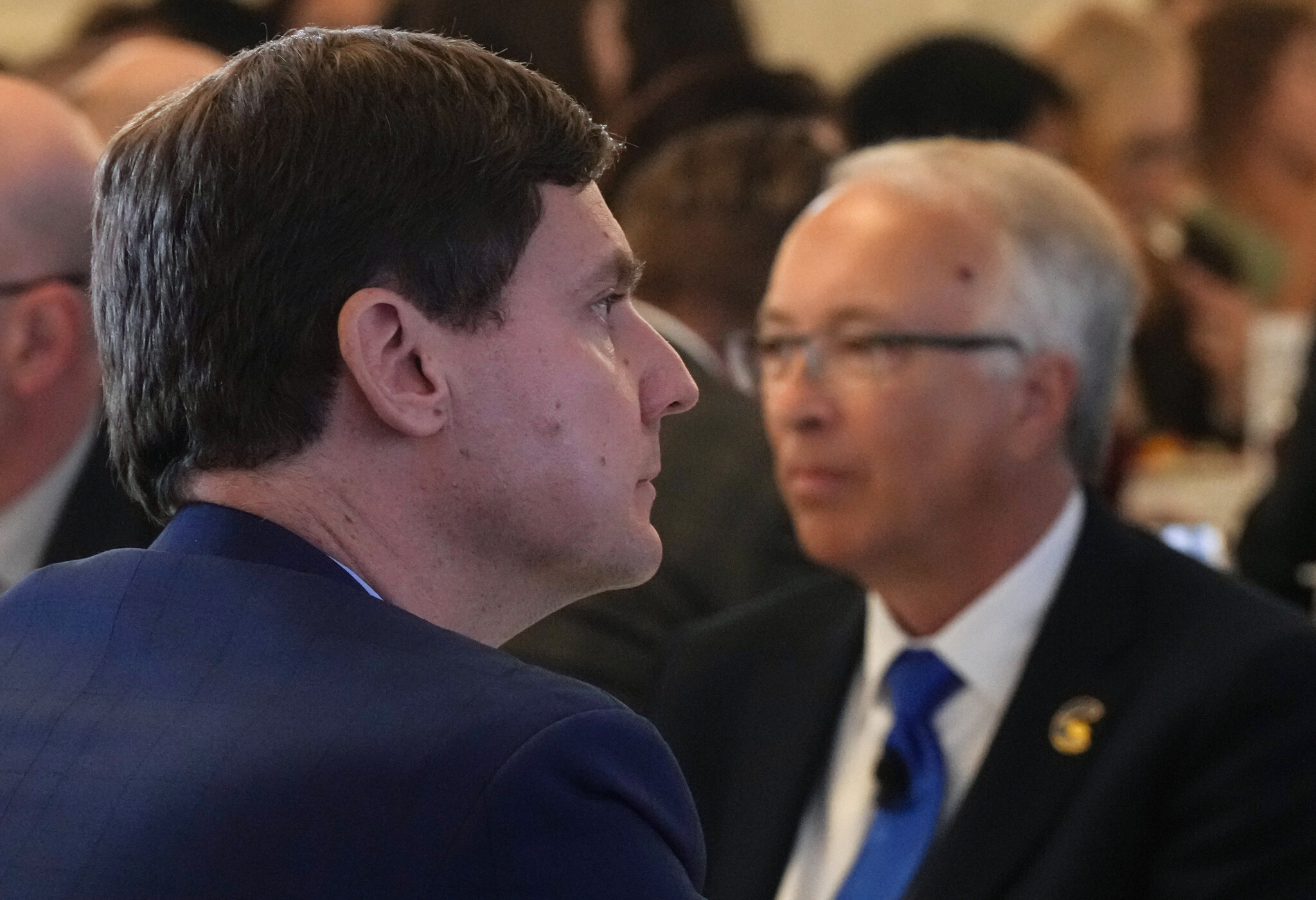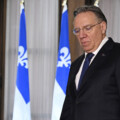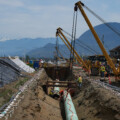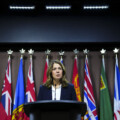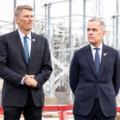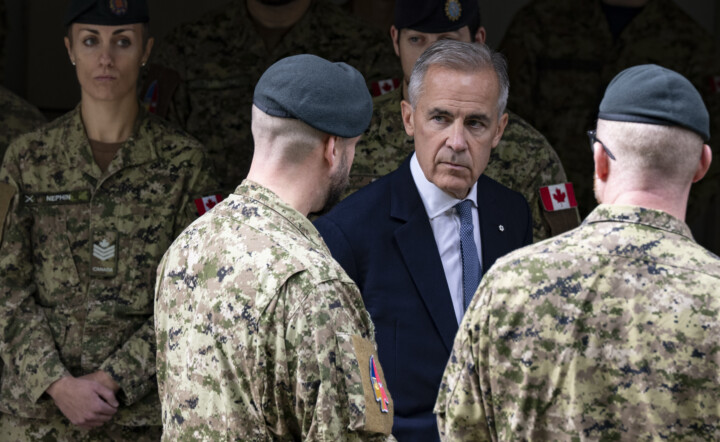An election campaign leaders’ debate, like the one Tuesday in British Columbia, means quite different things to people obsessed with politics and those too busy to be so. The participants better have objectives for the latter because the former have pretty well made up their minds.
It meant the three party leaders—BC NDP’s David Eby, Green Party’s Sonia Furstenau, and Conservative Party of BC’s John Rustad—had to jockey and pivot through the event to tick the boxes and answer the questions they wanted more than the questions they were asked.
The belief in the electoral value of the figurative knockout punch to the jaw of an opponent is a commentariat canard; more likely, voters are after statements that are knockouts of a good kind—that is, do they present the positive case for themselves, not just the negative one against the other candidates?
Eby needed to show that he gets the widespread discord in the province over how and how fast he’s moved; Furstenau needed to argue that the legislature needs some of her low-polling Greens as a watchdog; and Rustad needed to introduce himself and his demeanour to those non-obsessed citizens who had heard his party was on a roll and wanted to see what all the buzz was about.
On that basis, no one failed the test.
It’s unlikely the debate will disrupt the campaign’s trajectory of Conservative momentum that has an unclear ceiling and an NDP defensiveness of its record that has an unclear floor. Polls remain where they’ve been for weeks now, in what is called a statistical tie due to their margins of error. Once one party builds a nine or 10-point lead, we can call it, but that seems unlikely before the October 19 judgment day. I admit to more friends outside than inside the governing NDP, but at first canvass following the 90-minute TV show, neither cohort is cocky.
It’s now a ground war more than an air war.
The campaign will now move into the proverbial frenzy of finding friends in swing ridings, repeating core messages into self-nausea, and keeping eyes on your feet to step over the tripwires, open manholes, and landmines. The social media warriors neck-deep in this campaign won’t convince many, but the leaders at the microphones and particularly the candidates at the doors in the next week will.
The debate was much more about performance than policy, and in this case, there were elements that bear takeaways.
First, what worked best. Green leader Furstenau, in her second official leaders’ debate, is effective when she is afforded the same stage with (and exemption from criticism by) the main party leaders. The general take was that she created a difficult choice for voters angry at the NDP.
Eby, in his first debate (his leadership opponent was disqualified late in his 2022 party leadership campaign), is effective when he sticks to citing stats like an adult wonk and suppresses his frequent eye-rolling and the mugging displeasure of a child.
Rustad, a fellow rookie in these political tangos, is effective when he injects energy and uses personal examples to illustrate the social and economic conditions he says he would change.
There were some not-quite-good elements, too. Furstenau didn’t focus on hauling away the Left-of-Centre vote alongside her main focus on decrying Rustad. Eby didn’t focus on what new prescriptions he had alongside his main focus on denouncing Rustad. And the decried, denounced Rustad was mild-mannerly and soft-spoken to a fault, letting himself be interrupted and “Left-splained” in early- to mid-sentence all show.
If Rustad is going to take the helm through the last week of the campaign, he needs to go where the debate almost never did: to the top issue. Namely, the affordability challenges British Columbians are suffering through, with no apparent NDP strategy to address this, except Eby’s addiction to writing cheques from the taxpayers’ bank accounts and claiming this is a problem everywhere and thus not any of his doing. Sound familiar Mr. Trudeau?
Conservatives have their own rebates and relief measures in mind, but they also have a revenue and restoration plan of resource development and tax reforms to stimulate our stagnant economy. Neither questions nor answers in the debate explored what Rustad and his candidates will now need to exploit.
The most open question isn’t whether the Conservatives can fix the script but whether they possess the machinery known in politics as “GOTV.” Getting Out The Vote on E-Day after voter ID is, in the end, all that matters by night’s end. In this sense, Conservatives are little different than a startup business intent on disrupting a legacy industry.
It bears reminding that little more than 13 months ago, they weren’t even a recognized party in the B.C. chamber: just Rustad, fired by BC Liberals leader Kevin Falcon, a lone legislative presence for a Conservative party that hadn’t elected anyone in a half-century (and that MLA soon left).
When another BC Liberal crossed the floor in September 2023, Conservatives gained official status to participate in question period, debates, committees and procedures, and to receive legislature funds for staff and research. From a statistical polling rounding error of three or four percent a year ago, the party has propelled itself into a statistical tie, and in many polls a slight lead.
Along the way, Falcon ill-advisedly changed his party’s name to BC United and so struggled to connect and so seriously collapsed its standing that he was compelled to extraordinarily suspend its campaign in mid-August. Ostensibly he wanted to see late in the day if that could unite the Right.
The jury is still out on whether the more conservative element of United had already fled to Rustad by then, or if there are still more who will migrate to the Conservatives one week Saturday. No question, the change option on offer is stark when it comes to the financial and social involvement of government.
Public opinion in B.C. is increasingly uncomfortable with Eby’s handling of the economy and worsening public finances. Many are infuriated by hospital wait times, scared about safety on our streets, and impatient with his plans to address housing construction and unaffordability. This election was supposed to be a referendum on his performance, but he has found ways to deflect some of this into a referendum on the change agent.
A major mystery is whether Rustad will be such a target that traditional Greens will abandon their party for the NDP and traditional Liberals will hold their noses to entrench the Dippers. If British Columbians have been fed an image of Rustad by opponents, it has been a harsh caricature of a wolf in sheep’s clothing—a climate change denier, health-care slasher, and vaccine repudiator. All untrue.
More accurate is that he thinks that there are immediate crises more urgent than climate change at the moment, that there are health care efficiencies that would be more profound than blindly pouring more money into the system, and that there were pandemic restrictions that proved (more and more in hindsight) to be ridiculous.
That being said, the recent campaign days have created conundrums. For the Conservatives, it’s whether voters who dislike Eby are prepared to waste their ballots on the Greens rather than vote for them. Much of that is predicated on Rustad and the residuals of his campaign performance.
In exclusive polling for The Hub, the polling firm Pollara says it now finds that one-quarter are so mad they’re considering either spoiling their ballots or staying home.
Regardless, in just a few months, Rustad and the Conservatives have created the government’s existential crisis, the result of which we won’t know until next Saturday’s outcome. Those claiming certainty on it aren’t even fooling themselves.
